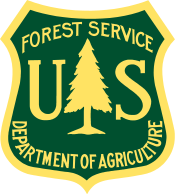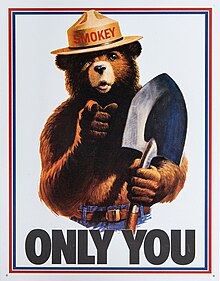United States Forest Service: Difference between revisions
updating link, possibly some formatting/rephrasings, using AWB |
m more details about lands that FS research is done on |
||
| Line 31: | Line 31: | ||
[[Image:US-national-forest-service-lands.png|thumb|350px|left|More than 80% of the 193 million acres (780,000 km²) of land managed by the National Forest Service is in the western states. This map shows NFS lands as a percentage of total land area in each state.<ref>[http://www.wildlandfire.com/docs/2007/western-states-data-public-land.htm Western States Data Public Land Acreage<!--Bot-generated title-->]</ref>]] |
[[Image:US-national-forest-service-lands.png|thumb|350px|left|More than 80% of the 193 million acres (780,000 km²) of land managed by the National Forest Service is in the western states. This map shows NFS lands as a percentage of total land area in each state.<ref>[http://www.wildlandfire.com/docs/2007/western-states-data-public-land.htm Western States Data Public Land Acreage<!--Bot-generated title-->]</ref>]] |
||
Across the United States, there are 155 [[United States National Forest|national forests]], organized into ranger districts employing [[district ranger]]s and other personnel. The districts construct and maintain trails, operate campgrounds, regulate [[grazing]], patrol [[wilderness area]]s, protect culturally significant heritage sites, and manage vegetation and [[wildlife]] [[Habitat (ecology)|habitat]]. The Forest Service also has seven regional research stations, including the International Institute of Tropical Forestry and Forest Products Laboratory, that study the ecosystems of the national forests. The Forest Service also provides funding and technical assistance to non-federal land owners through a branch called State and Private Forestry. |
Across the United States, there are 155 [[United States National Forest|national forests]], organized into ranger districts employing [[district ranger]]s and other personnel. The districts construct and maintain trails, operate campgrounds, regulate [[grazing]], patrol [[wilderness area]]s, protect culturally significant heritage sites, and manage vegetation and [[wildlife]] [[Habitat (ecology)|habitat]]. The Forest Service also has seven regional research stations, including the International Institute of Tropical Forestry and Forest Products Laboratory, that study the ecosystems of the national forests, as well as other federal, state, and private lands. The Forest Service also provides funding and technical assistance to non-federal land owners through a branch called State and Private Forestry. |
||
Although a large volume of [[Lumber|timber]] is [[Logging|logged]] every year, not all [[National Forests]] are entirely forested. There are tidewater glaciers in the [[Tongass National Forest]] in [[Alaska]] and ski areas such as [[Alta, Utah]] in the [[Wasatch-Cache National Forest]]. In addition, the Forest Service is responsible for managing [[National Grassland]]s in the midwest. Furthermore, areas designated as wilderness by acts of [[U.S. Congress|Congress]], prohibit logging, mining, road and building construction and land leases for purposes of farming and or livestock grazing. |
Although a large volume of [[Lumber|timber]] is [[Logging|logged]] every year, not all [[National Forests]] are entirely forested. There are tidewater glaciers in the [[Tongass National Forest]] in [[Alaska]] and ski areas such as [[Alta, Utah]] in the [[Wasatch-Cache National Forest]]. In addition, the Forest Service is responsible for managing [[National Grassland]]s in the midwest. Furthermore, areas designated as wilderness by acts of [[U.S. Congress|Congress]], prohibit logging, mining, road and building construction and land leases for purposes of farming and or livestock grazing. |
||
Revision as of 05:24, 19 November 2008
 Logo of the U.S. Forest Service. | |
| Agency overview | |
|---|---|
| Formed | 1905 |
| Preceding agency |
|
| Jurisdiction | Federal Government of the United States |
| Agency executive |
|
| Parent agency | United States Department of Agriculture |
| Website | www.fs.fed.us |
The USDA Forest Service is an agency of the United States Department of Agriculture that administers the nation's 155 national forests and 20 national grasslands. Major divisions of the agency include the National Forest System, State and Private Forestry, and the Research and Development branch.
History
In 1876, Congress created the office of Special Agent in the Department of Agriculture to assess the state of the forests in the United States. Franklin B. Hough was appointed the head of the office. In 1881, the office was expanded into the newly-formed Division of Forestry. The Forest Reserve Act of 1891 authorized withdrawing land from the public domain as "forest reserves," managed by the Department of the Interior. In 1901, the Division of Forestry was renamed the Bureau of Forestry. The Transfer Act of 1905 transferred the management of forest reserves from the General Land Office of the Interior Department to the Bureau of Forestry, henceforth known as the USDA Forest Service. Gifford Pinchot was the first Chief Forester of the USFS.
Significant federal legislation affecting the Forest Service includes the Multiple Use Sustained Yield Act, P.L. 86-517; the National Forest Management Act, P.L. 94-588; the National Environmental Policy Act, P.L. 91-190; the Cooperative Forestry Assistance Act, P.L. 95-313; the Forest and Rangelands Renewable Resources Planning Act, P.L. 95-307; and the National Forest Management Act of 1976.
In March 2008, the House Subcommittee on Interior, Environment, and Related Agencies asked the GAO to evaluate whether the Forest Service should be moved from the Department of Agriculture to the Department of the Interior, which already includes the National Park Service, the Fish and Wildlife Service, and the Bureau of Land Management, managing some 438,000,000 acres (1,770,000 km2) of public land.[1]
Activities

Across the United States, there are 155 national forests, organized into ranger districts employing district rangers and other personnel. The districts construct and maintain trails, operate campgrounds, regulate grazing, patrol wilderness areas, protect culturally significant heritage sites, and manage vegetation and wildlife habitat. The Forest Service also has seven regional research stations, including the International Institute of Tropical Forestry and Forest Products Laboratory, that study the ecosystems of the national forests, as well as other federal, state, and private lands. The Forest Service also provides funding and technical assistance to non-federal land owners through a branch called State and Private Forestry.
Although a large volume of timber is logged every year, not all National Forests are entirely forested. There are tidewater glaciers in the Tongass National Forest in Alaska and ski areas such as Alta, Utah in the Wasatch-Cache National Forest. In addition, the Forest Service is responsible for managing National Grasslands in the midwest. Furthermore, areas designated as wilderness by acts of Congress, prohibit logging, mining, road and building construction and land leases for purposes of farming and or livestock grazing.
Since 1978, several Presidents have directed the USFS to administer National Monuments inside of preexisting National Forests.
- Admiralty Island National Monument - Alaska
- Giant Sequoia National Monument - California
- Misty Fjords National Monument - Alaska
- Mount St. Helens National Volcanic Monument - Washington
- Newberry National Volcanic Monument - Oregon
- Santa Rosa and San Jacinto Mountains National Monument - California (jointly with the Bureau of Land Management)
The Forest Service also manages Grey Towers National Historic Site in Milford, Pennsylvania, the home and estate of its first director, Gifford Pinchot.
The U.S. Forest Service Law Enforcement & Investigations unit (LEI), headquartered in Washington, D.C., is a federal law enforcement agency of the U.S. government. It is responsible for enforcement of federal laws and regulations governing national forest lands and resources. Special agents are primarily used for investigations. Patrols are done primarily by uniformed law enforcement officers, all of whom carry firearms. The LEI also has K-9 and mounted police units.
Controversies

The history of the Forest Service has been fraught with controversy, as various interests and national values have grappled with the appropriate management of the many resources within the forests. These values and resources include grazing, timber, mining, recreation, and wildlife habitat. Because of continuing development elsewhere, the large size of National Forests have made them de facto wildlife reserves for a number of rare and common species. In recent decades, the importance of mature forest for the spotted owl and a number of other species led to great changes in timber harvest levels.
In August 1944, to reduce the number of forest fires, the Forest Service and the Wartime Advertising Council began distributing fire education posters featuring a Black Bear. The poster campaign was a success; the Black Bear would later be named "Smokey Bear," and would, for decades, be the "spokesbear" for the Forest Service. Smokey Bear has appeared in untold TV commercials; his popular catch phrase, "Only YOU can prevent forest fires", is one of the most widely recognized slogans in the United States. A recent study found that 95% of the people surveyed could complete the phrase when given the first few words.[3] Unfortunately, in certain fire-adapted ecosystems the ensuing decades of fire suppression unintentionally caused a buildup of fuels that replaced the historically natural fire regime of slow-burning, relatively cool fires with fast-burning, relatively hot wildfires in the fire-adapted forest lands across the nation.
In the 1990s, the agency was involved in scandal when it illegally provided surplus military aircraft to private contractors for use as airtankers. (See U.S. Forest Service airtanker scandal.)
Another controversial issue is the policy on road building within the National Forests. In 1999 President Clinton ordered a temporary moratorium on new road construction in the National Forests to "assess their ecological, economic, and social values and to evaluate long-term options for their management." [1] Five and half years later the Bush administration replaced this with a system where each state could petition the Forest Service to open forests in their territory to road building.
See also
References
- ^ Christopher Lee, "Forest Service May Move to Interior: Some See Agency As Out of Place Under the USDA", Washington Post, March 25, 2008
- ^ Western States Data Public Land Acreage
- ^ "The Story of Smokey Bear". United States Forest Service. Retrieved 2008-01-26.
External links
Management arm
- "USDA Forest Service".
{{cite web}}: Unknown parameter|accessmonthday=ignored (help); Unknown parameter|accessyear=ignored (|access-date=suggested) (help) - U.S. Forest Service Forest Products Laboratory
- U.S. Forest Service Pacific Wildland Fire Sciences Laboratory
- Forest Service Meeting Notices and Rule Changes from The Federal Register RSS Feed
- FSGeodata Clearinghouse: includes maps
- "USDA State & Private Forestry, Northeastern Area".
{{cite web}}: Unknown parameter|accessmonthday=ignored (help); Unknown parameter|accessyear=ignored (|access-date=suggested) (help)
Research arm
- Pacific Southwest Research Station
- Pacific Northwest Research Station
- Rocky Mountain Research Station
- Southern Research Station
- Northern Research Station
- Experimental Forests
- "USDA Forest Service Research Publications".
{{cite web}}: Unknown parameter|accessmonthday=ignored (help); Unknown parameter|accessyear=ignored (|access-date=suggested) (help)
